Exploring Personal Construct Theory and Social Constructionism
VerifiedAdded on 2020/04/01
|18
|5063
|40
Essay
AI Summary
The essay explores George Kelly's personal construct theory, which posits that individuals actively generate their own knowledge to understand the world, rather than merely perceiving it as a passive process. This theory is juxtaposed with social constructionism, highlighting both similarities and differences in how they conceptualize reality. While Kelly emphasizes individual agency in constructing understanding, social constructionism focuses on the collective creation of meaning within societies. The discussion extends to how personal constructs influence perceptions and interactions with socially constructed realities, offering insights into their coexistence and impact.
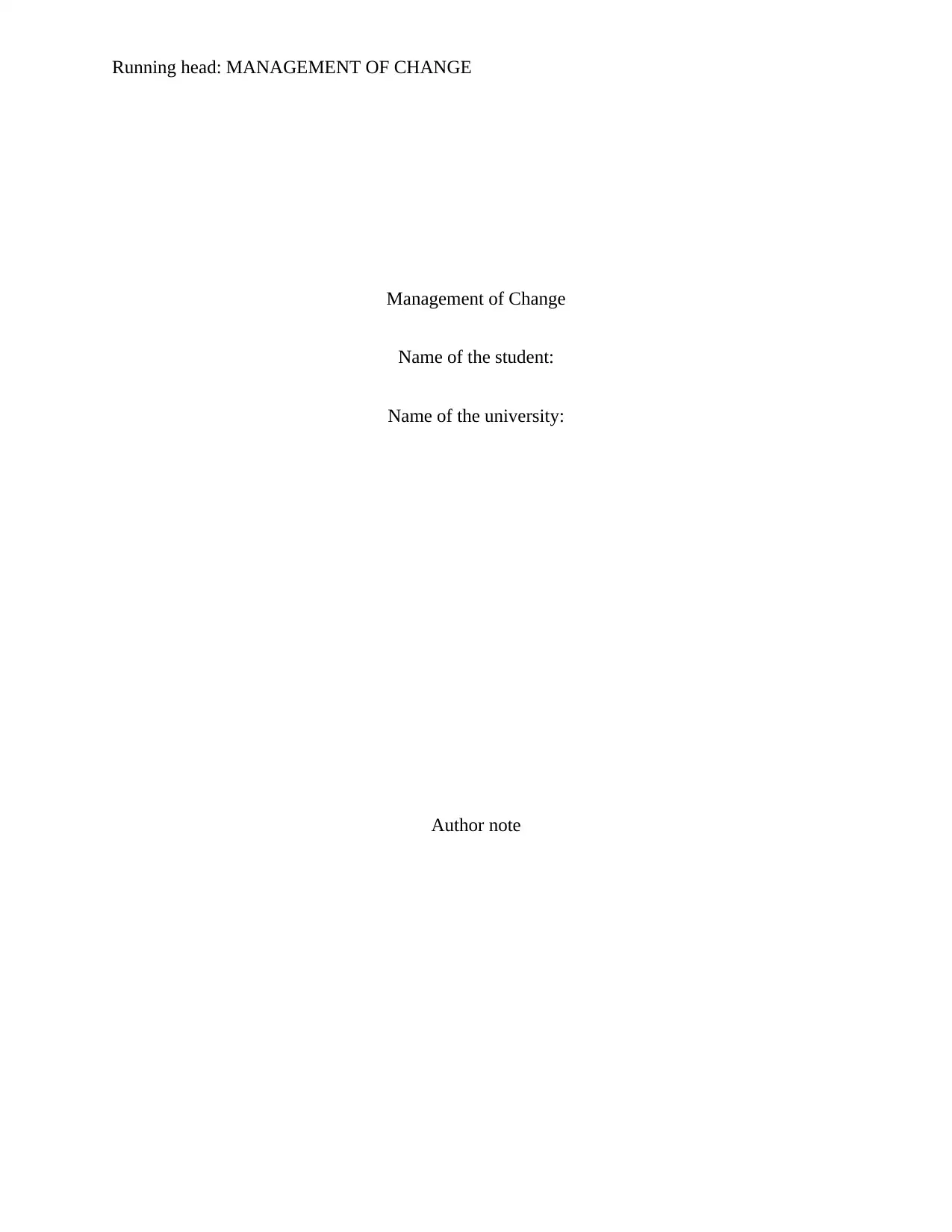
Running head: MANAGEMENT OF CHANGE
Management of Change
Name of the student:
Name of the university:
Author note
Management of Change
Name of the student:
Name of the university:
Author note
Paraphrase This Document
Need a fresh take? Get an instant paraphrase of this document with our AI Paraphraser
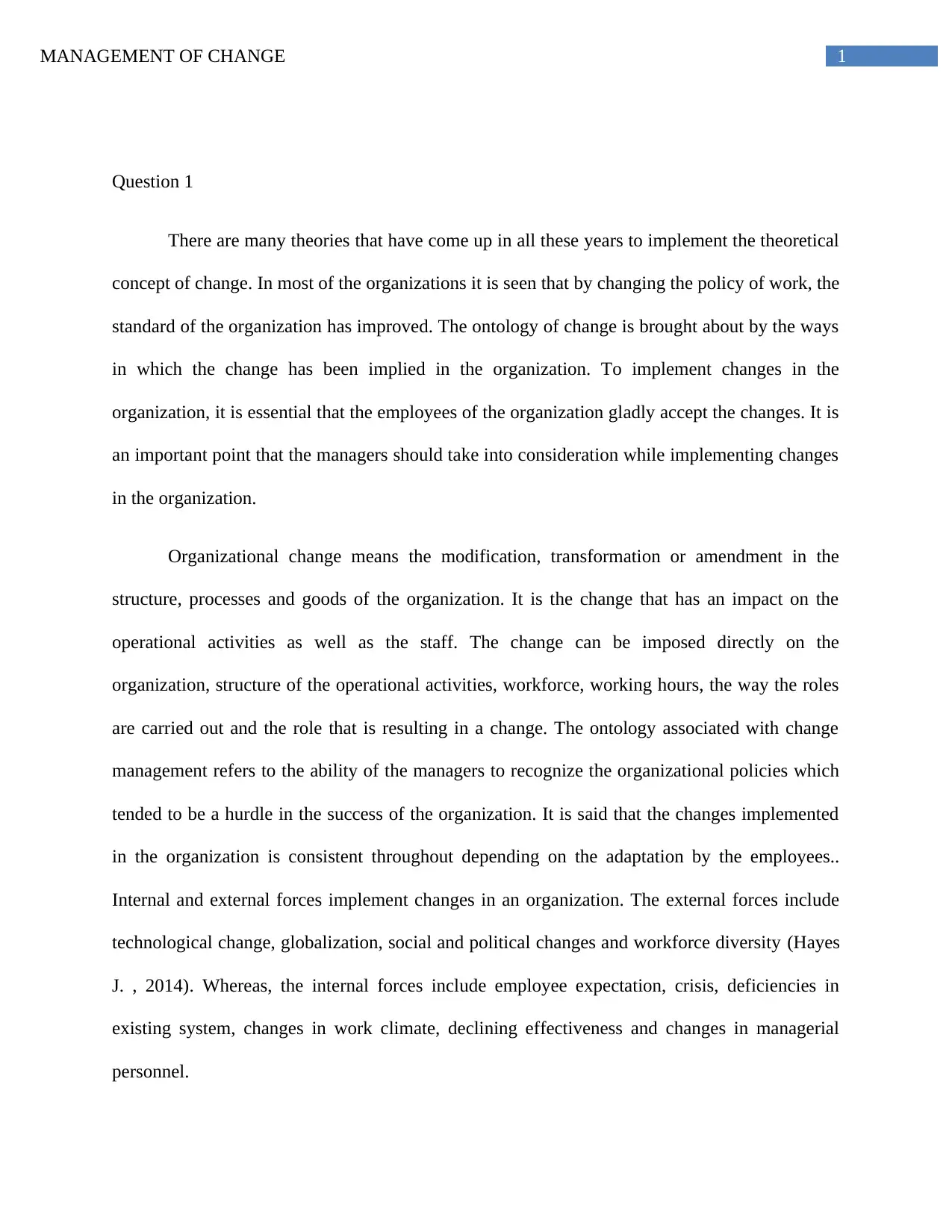
1MANAGEMENT OF CHANGE
Question 1
There are many theories that have come up in all these years to implement the theoretical
concept of change. In most of the organizations it is seen that by changing the policy of work, the
standard of the organization has improved. The ontology of change is brought about by the ways
in which the change has been implied in the organization. To implement changes in the
organization, it is essential that the employees of the organization gladly accept the changes. It is
an important point that the managers should take into consideration while implementing changes
in the organization.
Organizational change means the modification, transformation or amendment in the
structure, processes and goods of the organization. It is the change that has an impact on the
operational activities as well as the staff. The change can be imposed directly on the
organization, structure of the operational activities, workforce, working hours, the way the roles
are carried out and the role that is resulting in a change. The ontology associated with change
management refers to the ability of the managers to recognize the organizational policies which
tended to be a hurdle in the success of the organization. It is said that the changes implemented
in the organization is consistent throughout depending on the adaptation by the employees..
Internal and external forces implement changes in an organization. The external forces include
technological change, globalization, social and political changes and workforce diversity (Hayes
J. , 2014). Whereas, the internal forces include employee expectation, crisis, deficiencies in
existing system, changes in work climate, declining effectiveness and changes in managerial
personnel.
Question 1
There are many theories that have come up in all these years to implement the theoretical
concept of change. In most of the organizations it is seen that by changing the policy of work, the
standard of the organization has improved. The ontology of change is brought about by the ways
in which the change has been implied in the organization. To implement changes in the
organization, it is essential that the employees of the organization gladly accept the changes. It is
an important point that the managers should take into consideration while implementing changes
in the organization.
Organizational change means the modification, transformation or amendment in the
structure, processes and goods of the organization. It is the change that has an impact on the
operational activities as well as the staff. The change can be imposed directly on the
organization, structure of the operational activities, workforce, working hours, the way the roles
are carried out and the role that is resulting in a change. The ontology associated with change
management refers to the ability of the managers to recognize the organizational policies which
tended to be a hurdle in the success of the organization. It is said that the changes implemented
in the organization is consistent throughout depending on the adaptation by the employees..
Internal and external forces implement changes in an organization. The external forces include
technological change, globalization, social and political changes and workforce diversity (Hayes
J. , 2014). Whereas, the internal forces include employee expectation, crisis, deficiencies in
existing system, changes in work climate, declining effectiveness and changes in managerial
personnel.

2MANAGEMENT OF CHANGE
The three kinds of change in a workplace are unfreezing, change and refreezing.
Unfreezing refers to reducing forces for status quo; change refers to developing new attitudes,
behavior and values; refreezing refers to reinforcing new values, behavior and attitudes
(Cameron & Green, 2015). The management of organizational change is the framework
managing the effect of new and innovative business processes, changes in the organizational
structure or cultural changes in the organization. This is beneficial when there is necessity for the
whole organization to adapt o new skills and behavior. Lewin’s change management model or
McKinsey’s 7-S model are the two theories which are considered important for effective
innovation. Again, objectivism and social constructionism are the two very important aspects
which help in the analysis of organizational change. So, it can be mentioned that the changes in
organization can be driven for better comprehension of the process with respect to elementary
and rudimentary management studies. The theory of objectivism has no primary aim of an
individual to attain happiness. As the topic is based on organizational change, therefore the better
goals would be identified as the profit for the organization to attain the business practices
(Goetsch & Davis, 2014). On the other hand, constructionism deals with the practice of
knowledge and communication. The change in the form of communication is actually important
for developing a cohesive bond among the employees. Another important point to be considered
here is the constant communicative development which would contribute to the success in the
organization.
Question 2
a) In this context of organisational change, the Australian supermarket Coles is used as an
example for analysis by using the theories and concepts mentioned above. Globalisation has
again made it easy to evaporate a portion of the population and eradicate a part of the supply
The three kinds of change in a workplace are unfreezing, change and refreezing.
Unfreezing refers to reducing forces for status quo; change refers to developing new attitudes,
behavior and values; refreezing refers to reinforcing new values, behavior and attitudes
(Cameron & Green, 2015). The management of organizational change is the framework
managing the effect of new and innovative business processes, changes in the organizational
structure or cultural changes in the organization. This is beneficial when there is necessity for the
whole organization to adapt o new skills and behavior. Lewin’s change management model or
McKinsey’s 7-S model are the two theories which are considered important for effective
innovation. Again, objectivism and social constructionism are the two very important aspects
which help in the analysis of organizational change. So, it can be mentioned that the changes in
organization can be driven for better comprehension of the process with respect to elementary
and rudimentary management studies. The theory of objectivism has no primary aim of an
individual to attain happiness. As the topic is based on organizational change, therefore the better
goals would be identified as the profit for the organization to attain the business practices
(Goetsch & Davis, 2014). On the other hand, constructionism deals with the practice of
knowledge and communication. The change in the form of communication is actually important
for developing a cohesive bond among the employees. Another important point to be considered
here is the constant communicative development which would contribute to the success in the
organization.
Question 2
a) In this context of organisational change, the Australian supermarket Coles is used as an
example for analysis by using the theories and concepts mentioned above. Globalisation has
again made it easy to evaporate a portion of the population and eradicate a part of the supply
⊘ This is a preview!⊘
Do you want full access?
Subscribe today to unlock all pages.

Trusted by 1+ million students worldwide
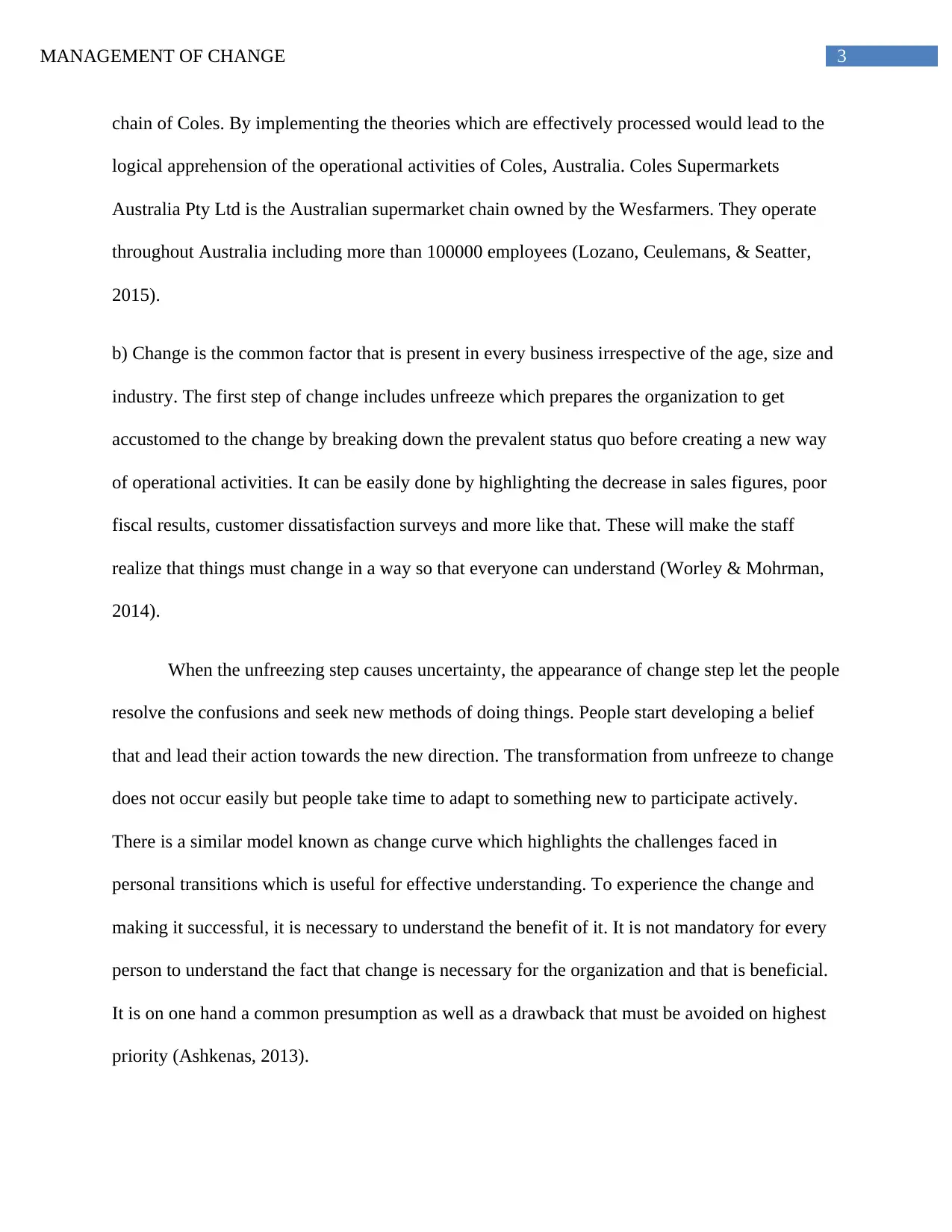
3MANAGEMENT OF CHANGE
chain of Coles. By implementing the theories which are effectively processed would lead to the
logical apprehension of the operational activities of Coles, Australia. Coles Supermarkets
Australia Pty Ltd is the Australian supermarket chain owned by the Wesfarmers. They operate
throughout Australia including more than 100000 employees (Lozano, Ceulemans, & Seatter,
2015).
b) Change is the common factor that is present in every business irrespective of the age, size and
industry. The first step of change includes unfreeze which prepares the organization to get
accustomed to the change by breaking down the prevalent status quo before creating a new way
of operational activities. It can be easily done by highlighting the decrease in sales figures, poor
fiscal results, customer dissatisfaction surveys and more like that. These will make the staff
realize that things must change in a way so that everyone can understand (Worley & Mohrman,
2014).
When the unfreezing step causes uncertainty, the appearance of change step let the people
resolve the confusions and seek new methods of doing things. People start developing a belief
that and lead their action towards the new direction. The transformation from unfreeze to change
does not occur easily but people take time to adapt to something new to participate actively.
There is a similar model known as change curve which highlights the challenges faced in
personal transitions which is useful for effective understanding. To experience the change and
making it successful, it is necessary to understand the benefit of it. It is not mandatory for every
person to understand the fact that change is necessary for the organization and that is beneficial.
It is on one hand a common presumption as well as a drawback that must be avoided on highest
priority (Ashkenas, 2013).
chain of Coles. By implementing the theories which are effectively processed would lead to the
logical apprehension of the operational activities of Coles, Australia. Coles Supermarkets
Australia Pty Ltd is the Australian supermarket chain owned by the Wesfarmers. They operate
throughout Australia including more than 100000 employees (Lozano, Ceulemans, & Seatter,
2015).
b) Change is the common factor that is present in every business irrespective of the age, size and
industry. The first step of change includes unfreeze which prepares the organization to get
accustomed to the change by breaking down the prevalent status quo before creating a new way
of operational activities. It can be easily done by highlighting the decrease in sales figures, poor
fiscal results, customer dissatisfaction surveys and more like that. These will make the staff
realize that things must change in a way so that everyone can understand (Worley & Mohrman,
2014).
When the unfreezing step causes uncertainty, the appearance of change step let the people
resolve the confusions and seek new methods of doing things. People start developing a belief
that and lead their action towards the new direction. The transformation from unfreeze to change
does not occur easily but people take time to adapt to something new to participate actively.
There is a similar model known as change curve which highlights the challenges faced in
personal transitions which is useful for effective understanding. To experience the change and
making it successful, it is necessary to understand the benefit of it. It is not mandatory for every
person to understand the fact that change is necessary for the organization and that is beneficial.
It is on one hand a common presumption as well as a drawback that must be avoided on highest
priority (Ashkenas, 2013).
Paraphrase This Document
Need a fresh take? Get an instant paraphrase of this document with our AI Paraphraser
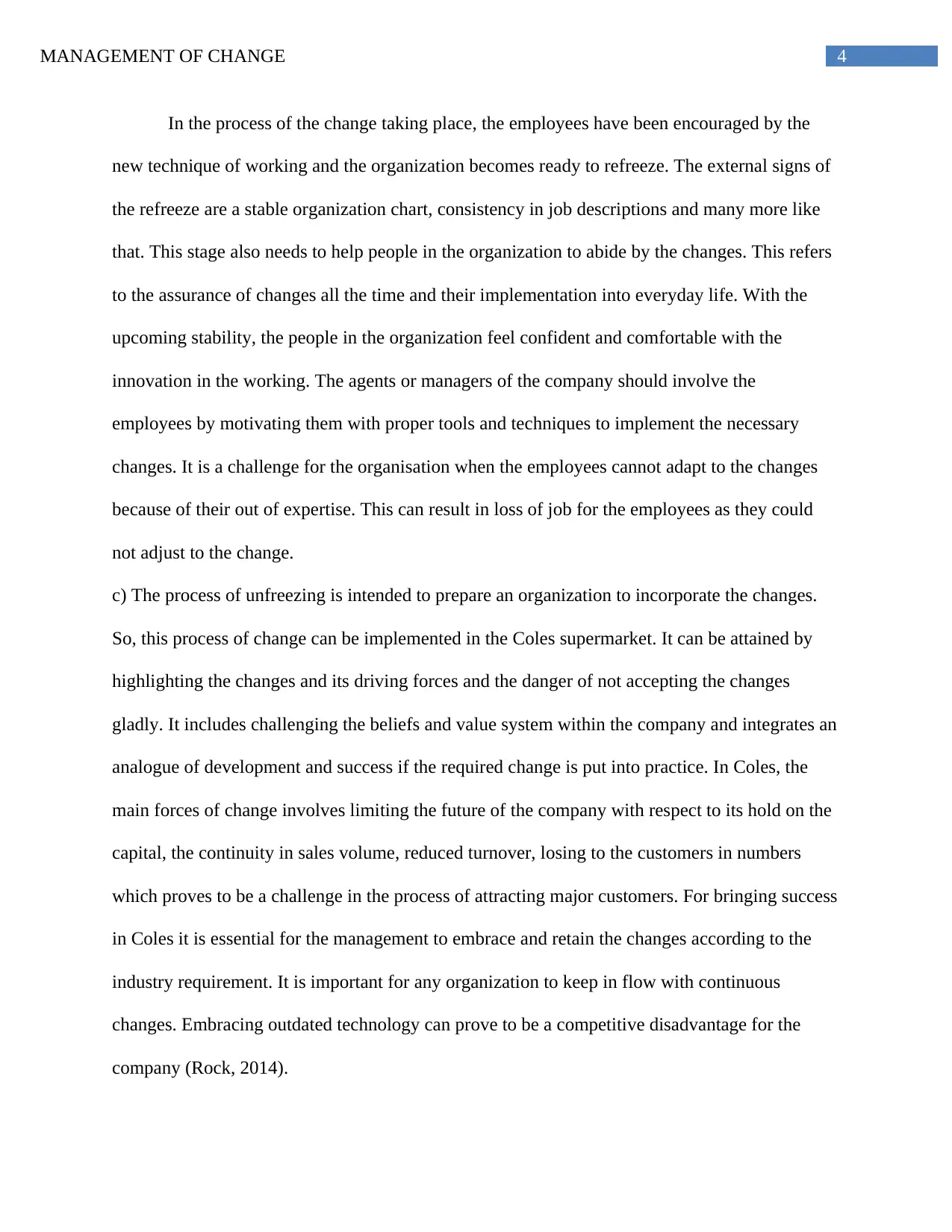
4MANAGEMENT OF CHANGE
In the process of the change taking place, the employees have been encouraged by the
new technique of working and the organization becomes ready to refreeze. The external signs of
the refreeze are a stable organization chart, consistency in job descriptions and many more like
that. This stage also needs to help people in the organization to abide by the changes. This refers
to the assurance of changes all the time and their implementation into everyday life. With the
upcoming stability, the people in the organization feel confident and comfortable with the
innovation in the working. The agents or managers of the company should involve the
employees by motivating them with proper tools and techniques to implement the necessary
changes. It is a challenge for the organisation when the employees cannot adapt to the changes
because of their out of expertise. This can result in loss of job for the employees as they could
not adjust to the change.
c) The process of unfreezing is intended to prepare an organization to incorporate the changes.
So, this process of change can be implemented in the Coles supermarket. It can be attained by
highlighting the changes and its driving forces and the danger of not accepting the changes
gladly. It includes challenging the beliefs and value system within the company and integrates an
analogue of development and success if the required change is put into practice. In Coles, the
main forces of change involves limiting the future of the company with respect to its hold on the
capital, the continuity in sales volume, reduced turnover, losing to the customers in numbers
which proves to be a challenge in the process of attracting major customers. For bringing success
in Coles it is essential for the management to embrace and retain the changes according to the
industry requirement. It is important for any organization to keep in flow with continuous
changes. Embracing outdated technology can prove to be a competitive disadvantage for the
company (Rock, 2014).
In the process of the change taking place, the employees have been encouraged by the
new technique of working and the organization becomes ready to refreeze. The external signs of
the refreeze are a stable organization chart, consistency in job descriptions and many more like
that. This stage also needs to help people in the organization to abide by the changes. This refers
to the assurance of changes all the time and their implementation into everyday life. With the
upcoming stability, the people in the organization feel confident and comfortable with the
innovation in the working. The agents or managers of the company should involve the
employees by motivating them with proper tools and techniques to implement the necessary
changes. It is a challenge for the organisation when the employees cannot adapt to the changes
because of their out of expertise. This can result in loss of job for the employees as they could
not adjust to the change.
c) The process of unfreezing is intended to prepare an organization to incorporate the changes.
So, this process of change can be implemented in the Coles supermarket. It can be attained by
highlighting the changes and its driving forces and the danger of not accepting the changes
gladly. It includes challenging the beliefs and value system within the company and integrates an
analogue of development and success if the required change is put into practice. In Coles, the
main forces of change involves limiting the future of the company with respect to its hold on the
capital, the continuity in sales volume, reduced turnover, losing to the customers in numbers
which proves to be a challenge in the process of attracting major customers. For bringing success
in Coles it is essential for the management to embrace and retain the changes according to the
industry requirement. It is important for any organization to keep in flow with continuous
changes. Embracing outdated technology can prove to be a competitive disadvantage for the
company (Rock, 2014).

5MANAGEMENT OF CHANGE
Question 3
a)
Strength Weakness
Reduction in cost
Attention on employee integration
Change in the organisation for improving
operational quality
Occupy a major share in the food and liquor market
Attractive pricing strategies
Sudden cut from the jobs will discourage the
employees and create a gap among the
management and the employees
They operate on lower margins as compared to
their competitors
Security can be threatened with respect to job
retention by creating tension among the employees
which has resulted an increase in the rate of
turnover of employees (Cawsey, 2016)
Opportunity Threat
To produce profit at a multiple point
Hold better control of the supply chain
The change in an organisation in the human
resource department has caused in a wider room for
the organization to make up a new team which will
be liable for utilising the power of the existing
workforce (Gollenia, 2016)
The company will face a threat which must be
addressed in the recent future. The new recruitment
must be entrusted with the operations of the
organization. So, it can be mentioned that the cost
behind the maintenance of human resource
department is the recent threat faced by the
supermarket Coles. The Australian food and liquor
market is in constant evolution.
From the given situational analysis by means of SWOT, it can be concluded that in
majority cases, the company deals with the change occurring in the human resource department
Question 3
a)
Strength Weakness
Reduction in cost
Attention on employee integration
Change in the organisation for improving
operational quality
Occupy a major share in the food and liquor market
Attractive pricing strategies
Sudden cut from the jobs will discourage the
employees and create a gap among the
management and the employees
They operate on lower margins as compared to
their competitors
Security can be threatened with respect to job
retention by creating tension among the employees
which has resulted an increase in the rate of
turnover of employees (Cawsey, 2016)
Opportunity Threat
To produce profit at a multiple point
Hold better control of the supply chain
The change in an organisation in the human
resource department has caused in a wider room for
the organization to make up a new team which will
be liable for utilising the power of the existing
workforce (Gollenia, 2016)
The company will face a threat which must be
addressed in the recent future. The new recruitment
must be entrusted with the operations of the
organization. So, it can be mentioned that the cost
behind the maintenance of human resource
department is the recent threat faced by the
supermarket Coles. The Australian food and liquor
market is in constant evolution.
From the given situational analysis by means of SWOT, it can be concluded that in
majority cases, the company deals with the change occurring in the human resource department
⊘ This is a preview!⊘
Do you want full access?
Subscribe today to unlock all pages.

Trusted by 1+ million students worldwide
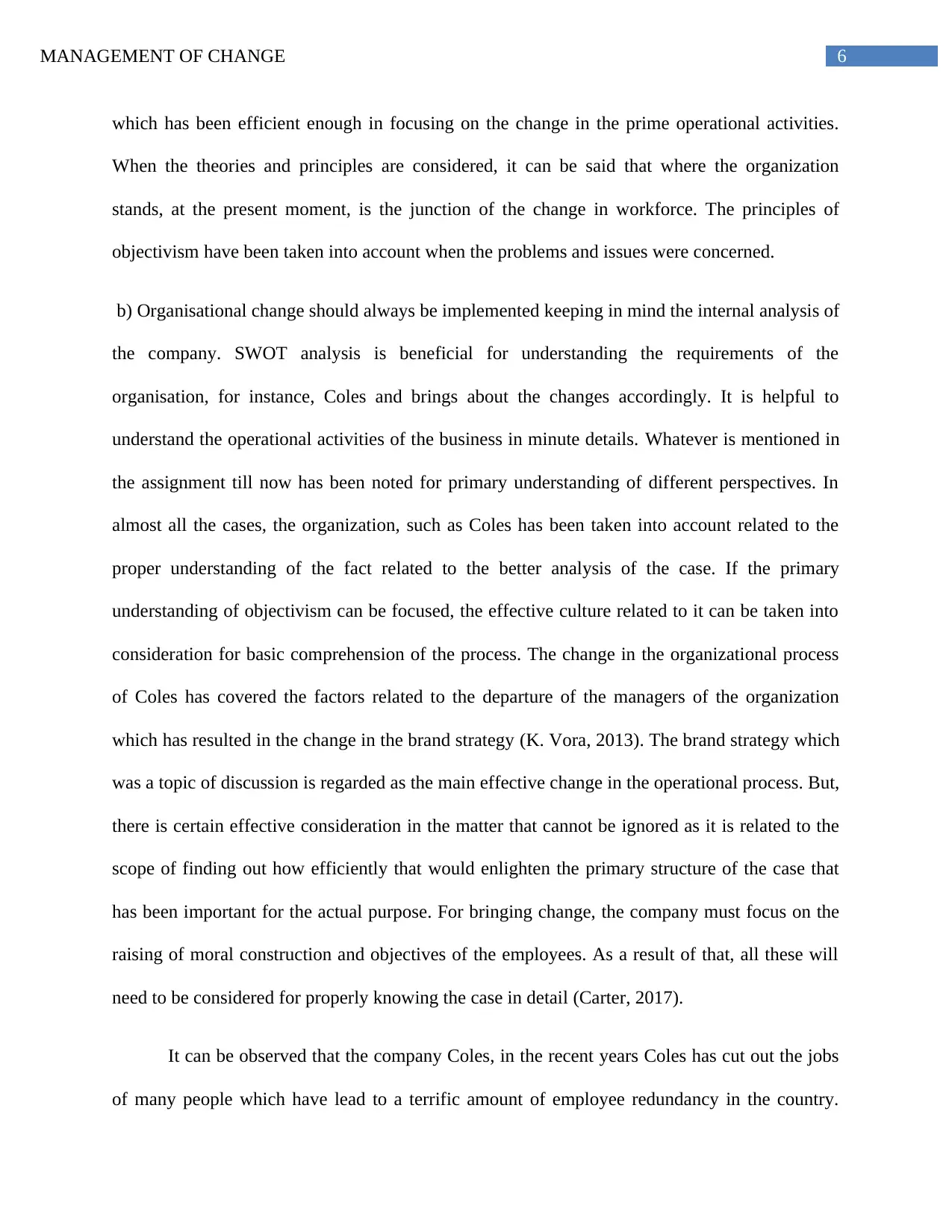
6MANAGEMENT OF CHANGE
which has been efficient enough in focusing on the change in the prime operational activities.
When the theories and principles are considered, it can be said that where the organization
stands, at the present moment, is the junction of the change in workforce. The principles of
objectivism have been taken into account when the problems and issues were concerned.
b) Organisational change should always be implemented keeping in mind the internal analysis of
the company. SWOT analysis is beneficial for understanding the requirements of the
organisation, for instance, Coles and brings about the changes accordingly. It is helpful to
understand the operational activities of the business in minute details. Whatever is mentioned in
the assignment till now has been noted for primary understanding of different perspectives. In
almost all the cases, the organization, such as Coles has been taken into account related to the
proper understanding of the fact related to the better analysis of the case. If the primary
understanding of objectivism can be focused, the effective culture related to it can be taken into
consideration for basic comprehension of the process. The change in the organizational process
of Coles has covered the factors related to the departure of the managers of the organization
which has resulted in the change in the brand strategy (K. Vora, 2013). The brand strategy which
was a topic of discussion is regarded as the main effective change in the operational process. But,
there is certain effective consideration in the matter that cannot be ignored as it is related to the
scope of finding out how efficiently that would enlighten the primary structure of the case that
has been important for the actual purpose. For bringing change, the company must focus on the
raising of moral construction and objectives of the employees. As a result of that, all these will
need to be considered for properly knowing the case in detail (Carter, 2017).
It can be observed that the company Coles, in the recent years Coles has cut out the jobs
of many people which have lead to a terrific amount of employee redundancy in the country.
which has been efficient enough in focusing on the change in the prime operational activities.
When the theories and principles are considered, it can be said that where the organization
stands, at the present moment, is the junction of the change in workforce. The principles of
objectivism have been taken into account when the problems and issues were concerned.
b) Organisational change should always be implemented keeping in mind the internal analysis of
the company. SWOT analysis is beneficial for understanding the requirements of the
organisation, for instance, Coles and brings about the changes accordingly. It is helpful to
understand the operational activities of the business in minute details. Whatever is mentioned in
the assignment till now has been noted for primary understanding of different perspectives. In
almost all the cases, the organization, such as Coles has been taken into account related to the
proper understanding of the fact related to the better analysis of the case. If the primary
understanding of objectivism can be focused, the effective culture related to it can be taken into
consideration for basic comprehension of the process. The change in the organizational process
of Coles has covered the factors related to the departure of the managers of the organization
which has resulted in the change in the brand strategy (K. Vora, 2013). The brand strategy which
was a topic of discussion is regarded as the main effective change in the operational process. But,
there is certain effective consideration in the matter that cannot be ignored as it is related to the
scope of finding out how efficiently that would enlighten the primary structure of the case that
has been important for the actual purpose. For bringing change, the company must focus on the
raising of moral construction and objectives of the employees. As a result of that, all these will
need to be considered for properly knowing the case in detail (Carter, 2017).
It can be observed that the company Coles, in the recent years Coles has cut out the jobs
of many people which have lead to a terrific amount of employee redundancy in the country.
Paraphrase This Document
Need a fresh take? Get an instant paraphrase of this document with our AI Paraphraser
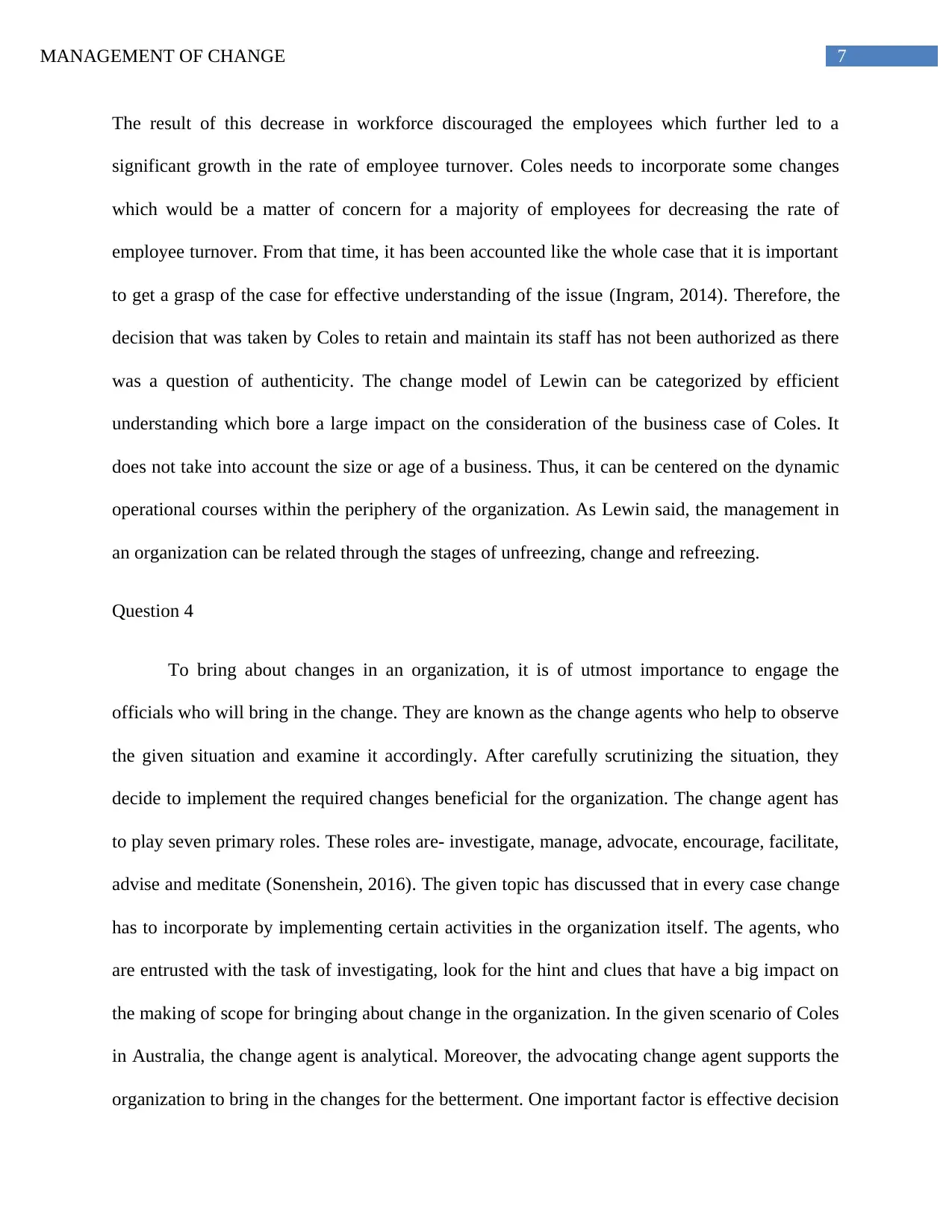
7MANAGEMENT OF CHANGE
The result of this decrease in workforce discouraged the employees which further led to a
significant growth in the rate of employee turnover. Coles needs to incorporate some changes
which would be a matter of concern for a majority of employees for decreasing the rate of
employee turnover. From that time, it has been accounted like the whole case that it is important
to get a grasp of the case for effective understanding of the issue (Ingram, 2014). Therefore, the
decision that was taken by Coles to retain and maintain its staff has not been authorized as there
was a question of authenticity. The change model of Lewin can be categorized by efficient
understanding which bore a large impact on the consideration of the business case of Coles. It
does not take into account the size or age of a business. Thus, it can be centered on the dynamic
operational courses within the periphery of the organization. As Lewin said, the management in
an organization can be related through the stages of unfreezing, change and refreezing.
Question 4
To bring about changes in an organization, it is of utmost importance to engage the
officials who will bring in the change. They are known as the change agents who help to observe
the given situation and examine it accordingly. After carefully scrutinizing the situation, they
decide to implement the required changes beneficial for the organization. The change agent has
to play seven primary roles. These roles are- investigate, manage, advocate, encourage, facilitate,
advise and meditate (Sonenshein, 2016). The given topic has discussed that in every case change
has to incorporate by implementing certain activities in the organization itself. The agents, who
are entrusted with the task of investigating, look for the hint and clues that have a big impact on
the making of scope for bringing about change in the organization. In the given scenario of Coles
in Australia, the change agent is analytical. Moreover, the advocating change agent supports the
organization to bring in the changes for the betterment. One important factor is effective decision
The result of this decrease in workforce discouraged the employees which further led to a
significant growth in the rate of employee turnover. Coles needs to incorporate some changes
which would be a matter of concern for a majority of employees for decreasing the rate of
employee turnover. From that time, it has been accounted like the whole case that it is important
to get a grasp of the case for effective understanding of the issue (Ingram, 2014). Therefore, the
decision that was taken by Coles to retain and maintain its staff has not been authorized as there
was a question of authenticity. The change model of Lewin can be categorized by efficient
understanding which bore a large impact on the consideration of the business case of Coles. It
does not take into account the size or age of a business. Thus, it can be centered on the dynamic
operational courses within the periphery of the organization. As Lewin said, the management in
an organization can be related through the stages of unfreezing, change and refreezing.
Question 4
To bring about changes in an organization, it is of utmost importance to engage the
officials who will bring in the change. They are known as the change agents who help to observe
the given situation and examine it accordingly. After carefully scrutinizing the situation, they
decide to implement the required changes beneficial for the organization. The change agent has
to play seven primary roles. These roles are- investigate, manage, advocate, encourage, facilitate,
advise and meditate (Sonenshein, 2016). The given topic has discussed that in every case change
has to incorporate by implementing certain activities in the organization itself. The agents, who
are entrusted with the task of investigating, look for the hint and clues that have a big impact on
the making of scope for bringing about change in the organization. In the given scenario of Coles
in Australia, the change agent is analytical. Moreover, the advocating change agent supports the
organization to bring in the changes for the betterment. One important factor is effective decision
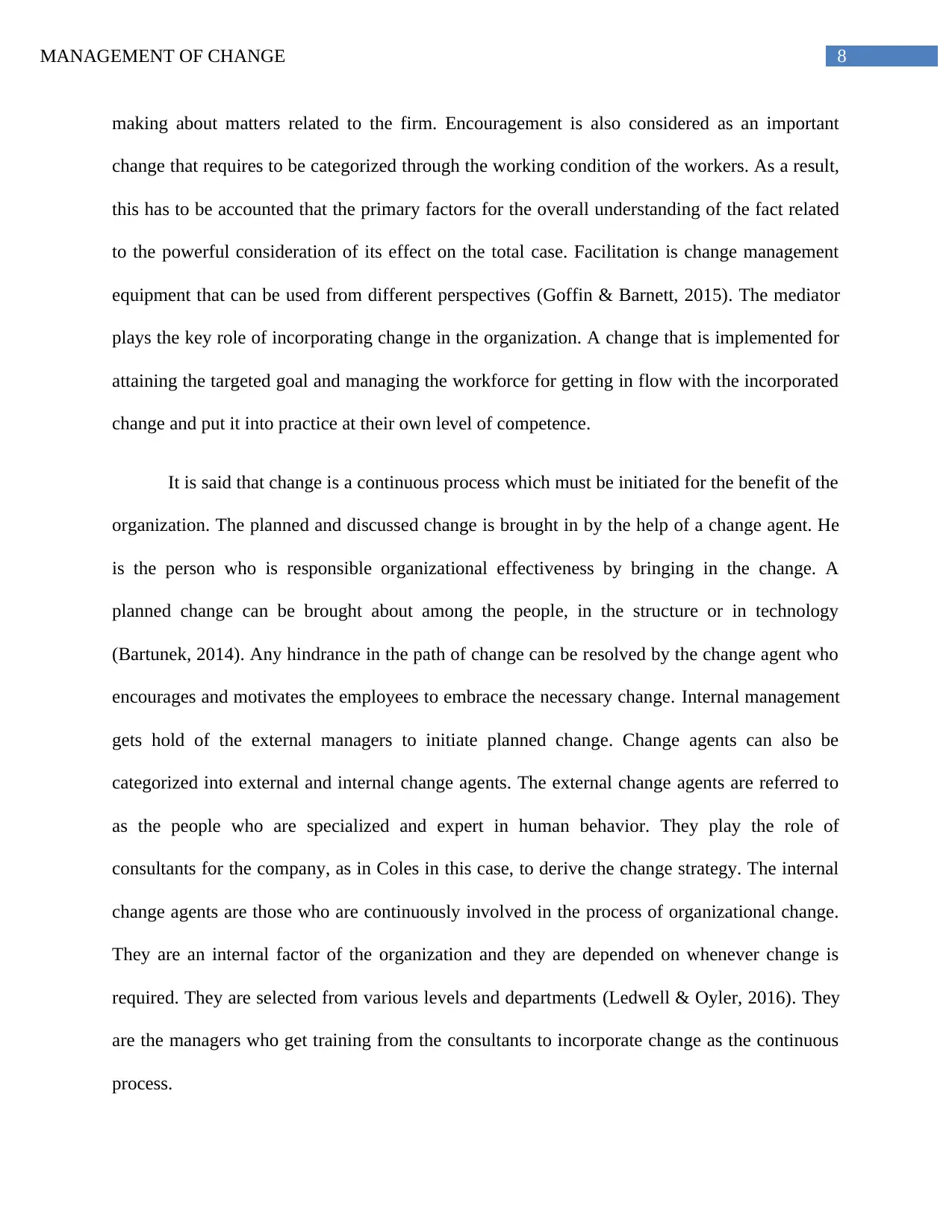
8MANAGEMENT OF CHANGE
making about matters related to the firm. Encouragement is also considered as an important
change that requires to be categorized through the working condition of the workers. As a result,
this has to be accounted that the primary factors for the overall understanding of the fact related
to the powerful consideration of its effect on the total case. Facilitation is change management
equipment that can be used from different perspectives (Goffin & Barnett, 2015). The mediator
plays the key role of incorporating change in the organization. A change that is implemented for
attaining the targeted goal and managing the workforce for getting in flow with the incorporated
change and put it into practice at their own level of competence.
It is said that change is a continuous process which must be initiated for the benefit of the
organization. The planned and discussed change is brought in by the help of a change agent. He
is the person who is responsible organizational effectiveness by bringing in the change. A
planned change can be brought about among the people, in the structure or in technology
(Bartunek, 2014). Any hindrance in the path of change can be resolved by the change agent who
encourages and motivates the employees to embrace the necessary change. Internal management
gets hold of the external managers to initiate planned change. Change agents can also be
categorized into external and internal change agents. The external change agents are referred to
as the people who are specialized and expert in human behavior. They play the role of
consultants for the company, as in Coles in this case, to derive the change strategy. The internal
change agents are those who are continuously involved in the process of organizational change.
They are an internal factor of the organization and they are depended on whenever change is
required. They are selected from various levels and departments (Ledwell & Oyler, 2016). They
are the managers who get training from the consultants to incorporate change as the continuous
process.
making about matters related to the firm. Encouragement is also considered as an important
change that requires to be categorized through the working condition of the workers. As a result,
this has to be accounted that the primary factors for the overall understanding of the fact related
to the powerful consideration of its effect on the total case. Facilitation is change management
equipment that can be used from different perspectives (Goffin & Barnett, 2015). The mediator
plays the key role of incorporating change in the organization. A change that is implemented for
attaining the targeted goal and managing the workforce for getting in flow with the incorporated
change and put it into practice at their own level of competence.
It is said that change is a continuous process which must be initiated for the benefit of the
organization. The planned and discussed change is brought in by the help of a change agent. He
is the person who is responsible organizational effectiveness by bringing in the change. A
planned change can be brought about among the people, in the structure or in technology
(Bartunek, 2014). Any hindrance in the path of change can be resolved by the change agent who
encourages and motivates the employees to embrace the necessary change. Internal management
gets hold of the external managers to initiate planned change. Change agents can also be
categorized into external and internal change agents. The external change agents are referred to
as the people who are specialized and expert in human behavior. They play the role of
consultants for the company, as in Coles in this case, to derive the change strategy. The internal
change agents are those who are continuously involved in the process of organizational change.
They are an internal factor of the organization and they are depended on whenever change is
required. They are selected from various levels and departments (Ledwell & Oyler, 2016). They
are the managers who get training from the consultants to incorporate change as the continuous
process.
⊘ This is a preview!⊘
Do you want full access?
Subscribe today to unlock all pages.

Trusted by 1+ million students worldwide
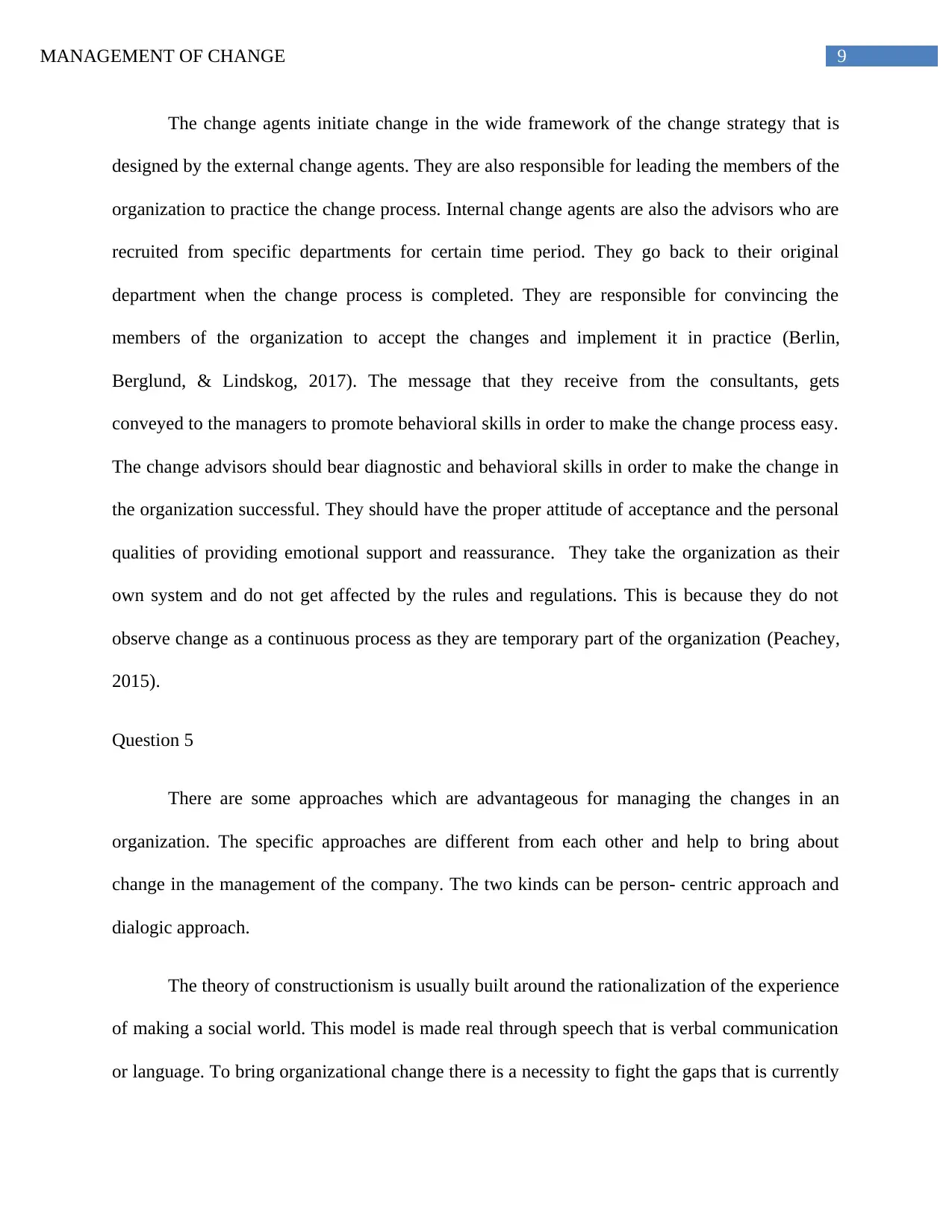
9MANAGEMENT OF CHANGE
The change agents initiate change in the wide framework of the change strategy that is
designed by the external change agents. They are also responsible for leading the members of the
organization to practice the change process. Internal change agents are also the advisors who are
recruited from specific departments for certain time period. They go back to their original
department when the change process is completed. They are responsible for convincing the
members of the organization to accept the changes and implement it in practice (Berlin,
Berglund, & Lindskog, 2017). The message that they receive from the consultants, gets
conveyed to the managers to promote behavioral skills in order to make the change process easy.
The change advisors should bear diagnostic and behavioral skills in order to make the change in
the organization successful. They should have the proper attitude of acceptance and the personal
qualities of providing emotional support and reassurance. They take the organization as their
own system and do not get affected by the rules and regulations. This is because they do not
observe change as a continuous process as they are temporary part of the organization (Peachey,
2015).
Question 5
There are some approaches which are advantageous for managing the changes in an
organization. The specific approaches are different from each other and help to bring about
change in the management of the company. The two kinds can be person- centric approach and
dialogic approach.
The theory of constructionism is usually built around the rationalization of the experience
of making a social world. This model is made real through speech that is verbal communication
or language. To bring organizational change there is a necessity to fight the gaps that is currently
The change agents initiate change in the wide framework of the change strategy that is
designed by the external change agents. They are also responsible for leading the members of the
organization to practice the change process. Internal change agents are also the advisors who are
recruited from specific departments for certain time period. They go back to their original
department when the change process is completed. They are responsible for convincing the
members of the organization to accept the changes and implement it in practice (Berlin,
Berglund, & Lindskog, 2017). The message that they receive from the consultants, gets
conveyed to the managers to promote behavioral skills in order to make the change process easy.
The change advisors should bear diagnostic and behavioral skills in order to make the change in
the organization successful. They should have the proper attitude of acceptance and the personal
qualities of providing emotional support and reassurance. They take the organization as their
own system and do not get affected by the rules and regulations. This is because they do not
observe change as a continuous process as they are temporary part of the organization (Peachey,
2015).
Question 5
There are some approaches which are advantageous for managing the changes in an
organization. The specific approaches are different from each other and help to bring about
change in the management of the company. The two kinds can be person- centric approach and
dialogic approach.
The theory of constructionism is usually built around the rationalization of the experience
of making a social world. This model is made real through speech that is verbal communication
or language. To bring organizational change there is a necessity to fight the gaps that is currently
Paraphrase This Document
Need a fresh take? Get an instant paraphrase of this document with our AI Paraphraser
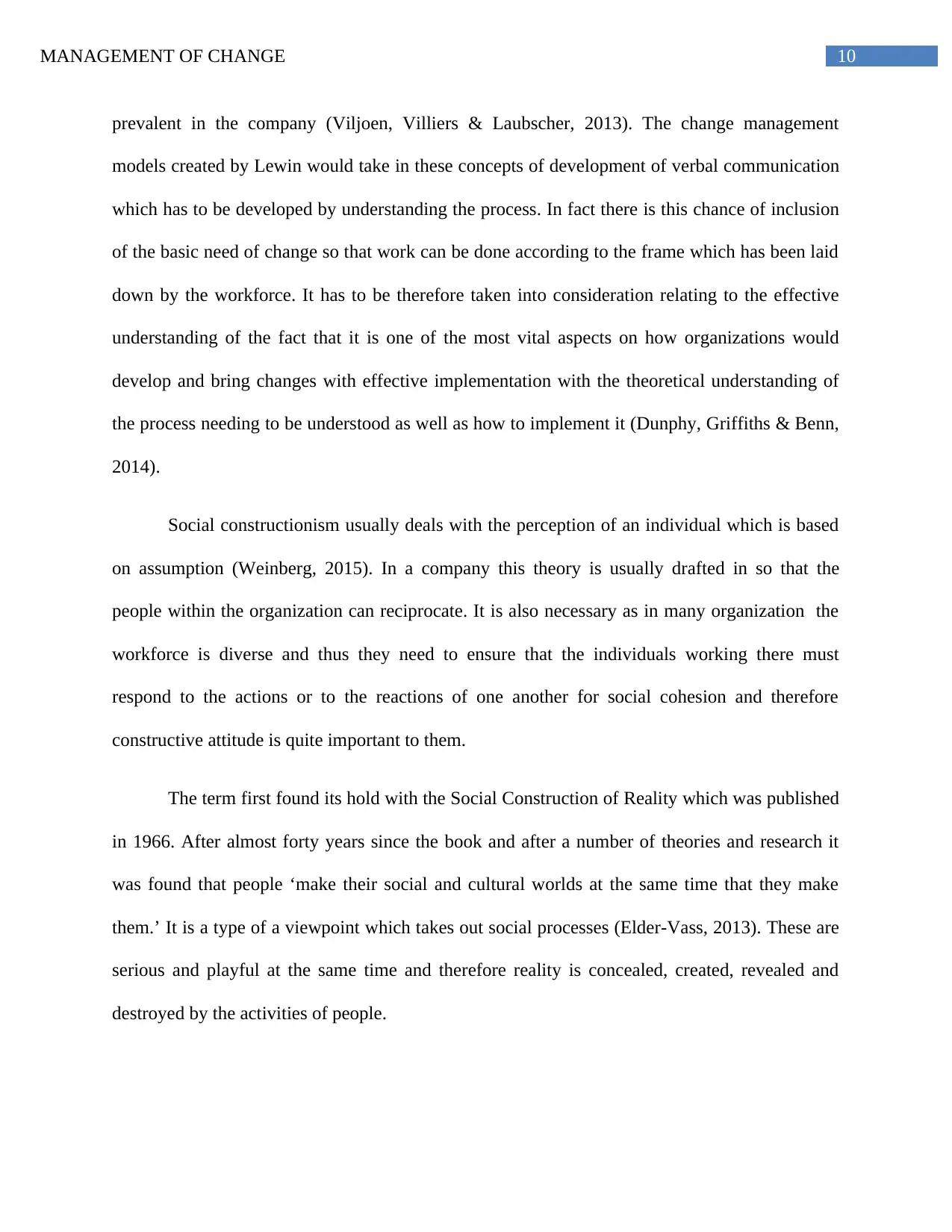
10MANAGEMENT OF CHANGE
prevalent in the company (Viljoen, Villiers & Laubscher, 2013). The change management
models created by Lewin would take in these concepts of development of verbal communication
which has to be developed by understanding the process. In fact there is this chance of inclusion
of the basic need of change so that work can be done according to the frame which has been laid
down by the workforce. It has to be therefore taken into consideration relating to the effective
understanding of the fact that it is one of the most vital aspects on how organizations would
develop and bring changes with effective implementation with the theoretical understanding of
the process needing to be understood as well as how to implement it (Dunphy, Griffiths & Benn,
2014).
Social constructionism usually deals with the perception of an individual which is based
on assumption (Weinberg, 2015). In a company this theory is usually drafted in so that the
people within the organization can reciprocate. It is also necessary as in many organization the
workforce is diverse and thus they need to ensure that the individuals working there must
respond to the actions or to the reactions of one another for social cohesion and therefore
constructive attitude is quite important to them.
The term first found its hold with the Social Construction of Reality which was published
in 1966. After almost forty years since the book and after a number of theories and research it
was found that people ‘make their social and cultural worlds at the same time that they make
them.’ It is a type of a viewpoint which takes out social processes (Elder-Vass, 2013). These are
serious and playful at the same time and therefore reality is concealed, created, revealed and
destroyed by the activities of people.
prevalent in the company (Viljoen, Villiers & Laubscher, 2013). The change management
models created by Lewin would take in these concepts of development of verbal communication
which has to be developed by understanding the process. In fact there is this chance of inclusion
of the basic need of change so that work can be done according to the frame which has been laid
down by the workforce. It has to be therefore taken into consideration relating to the effective
understanding of the fact that it is one of the most vital aspects on how organizations would
develop and bring changes with effective implementation with the theoretical understanding of
the process needing to be understood as well as how to implement it (Dunphy, Griffiths & Benn,
2014).
Social constructionism usually deals with the perception of an individual which is based
on assumption (Weinberg, 2015). In a company this theory is usually drafted in so that the
people within the organization can reciprocate. It is also necessary as in many organization the
workforce is diverse and thus they need to ensure that the individuals working there must
respond to the actions or to the reactions of one another for social cohesion and therefore
constructive attitude is quite important to them.
The term first found its hold with the Social Construction of Reality which was published
in 1966. After almost forty years since the book and after a number of theories and research it
was found that people ‘make their social and cultural worlds at the same time that they make
them.’ It is a type of a viewpoint which takes out social processes (Elder-Vass, 2013). These are
serious and playful at the same time and therefore reality is concealed, created, revealed and
destroyed by the activities of people.

11MANAGEMENT OF CHANGE
According to Ian Hacking, claims relating to social construction are not very clear always
as to what is not inevitable or as to what should be done way with to bring about the change.
Hackings distinction is purely based on metaphysics with a gap between things which are out
there in the world and the ideas which reside in the minds of the people.
To discuss it further one has to see the applications. First there is obviously the personal
construct psychology (Kruglanski & Higgins, 2013). It first appeared in the 1950s and has since
then grown as a constructivist theory relating to the personality and a system of changing
individual processes which bring out meaning in largely remedial processes. It was actually
based on individuals who create and test theories about their own worlds. Therefore, it brought
out one of the primitive attempts to laud the constructive nature of experience and meaning
individuals give to their personal experiences. On the other hand social constructionism grew as
a form of a critique which was aimed at changing the effects of oppressing social meaning
processes. Over a period of time it has developed into a cluster of different approaches.
There is this usual way of taking the relationship between PCP and SC as two different
entities which are similar but are also very separate in other ways. After personal construct
constructivism there is Educational psychology where social constructivism has been researched
and studied by many psychologists, the ones who are concerned with the implications of its
teaching and learning. Furthermore there is also the systematic therapy which is a form of
psychotherapy which wants to address individuals as people in relationships, dealing with how
groups interact and the way they interact that is the dynamics and patterns (Trevena, 2015).
Then there is the teleology of social construction, where the concepts of strong and weak
are put in to opposing philosophical positions. It is the goal oriented, meaningful or final end of
According to Ian Hacking, claims relating to social construction are not very clear always
as to what is not inevitable or as to what should be done way with to bring about the change.
Hackings distinction is purely based on metaphysics with a gap between things which are out
there in the world and the ideas which reside in the minds of the people.
To discuss it further one has to see the applications. First there is obviously the personal
construct psychology (Kruglanski & Higgins, 2013). It first appeared in the 1950s and has since
then grown as a constructivist theory relating to the personality and a system of changing
individual processes which bring out meaning in largely remedial processes. It was actually
based on individuals who create and test theories about their own worlds. Therefore, it brought
out one of the primitive attempts to laud the constructive nature of experience and meaning
individuals give to their personal experiences. On the other hand social constructionism grew as
a form of a critique which was aimed at changing the effects of oppressing social meaning
processes. Over a period of time it has developed into a cluster of different approaches.
There is this usual way of taking the relationship between PCP and SC as two different
entities which are similar but are also very separate in other ways. After personal construct
constructivism there is Educational psychology where social constructivism has been researched
and studied by many psychologists, the ones who are concerned with the implications of its
teaching and learning. Furthermore there is also the systematic therapy which is a form of
psychotherapy which wants to address individuals as people in relationships, dealing with how
groups interact and the way they interact that is the dynamics and patterns (Trevena, 2015).
Then there is the teleology of social construction, where the concepts of strong and weak
are put in to opposing philosophical positions. It is the goal oriented, meaningful or final end of
⊘ This is a preview!⊘
Do you want full access?
Subscribe today to unlock all pages.

Trusted by 1+ million students worldwide
1 out of 18
Related Documents
Your All-in-One AI-Powered Toolkit for Academic Success.
+13062052269
info@desklib.com
Available 24*7 on WhatsApp / Email
![[object Object]](/_next/static/media/star-bottom.7253800d.svg)
Unlock your academic potential
Copyright © 2020–2025 A2Z Services. All Rights Reserved. Developed and managed by ZUCOL.





